Highlight Above The Brow, Right Above The Very Tip Of The Arch Instead Of Under. This Will Help Lift
Highlight above the brow, right above the very tip of the arch instead of under. This will help lift the face without making the eyelids look puffy or accentuating stray hairs.
More Posts from Risingstarling and Others
Hey, you're awesome, thanks for existing, basically ^_^ Anyway, I wanted to know if you have any tips on how to write different personalities? My characters (all of them) always end up with the same default personality that I fall back on. Thanks!
Thanks for your question, darling! I think most of us have struggled with this – after all, we’re conditioned to one way of thinking, feeling, and acting for as long as we live. That doesn’t necessarily mean we write characters like ourselves, though. In fact, many of us have a “default character” that’s sassier than we are, sweeter than we are, or in some way different enough from us that we still feel like we’re writing a character.
The problem, then, isn’t that we can’t visualize a different personality than ours. On the whole, we can. What we’re missing are the small details that make it feel whole – otherwise, it’s like painting the same room six different colors and trying to pass it off as six different rooms. Different dominant traits can’t hide the fact that you’re working with one template!
So the question we’re left with: what are the traits we’re missing? And how can we change them to create a unique and whole personality?
Three Types of Character Traits
There are, as the title suggests, three major categories of personality traits as I see it: fundamental traits, acquired traits, and detrimental traits. A well-rounded character needs some of each to be three-dimensional and realistic.
Fundamental Traits
The fundamental traits of a person’s character are not as simple as interests and preferences; they are the very base of all decisions and desires. They are either learned in early life or developed over a long period of time, rooting deeply into the personality. A few examples of fundamental personality traits include:
Upbringing – The word choice here is conscious, as upbringing encompasses many different aspects of a person’s development. Consider who raised them, and with what morals and practices they were raised to adulthood. Consider their influences, both familial, social, and in media; consider the relationships that were normalized during their development, as well as the living conditions (financially, emotionally, environmentally, etc.). The people, places, emotions, and conflicts made common during a person’s developmental period are essential to their personality in adulthood. This is why psychologists often draw present-day problems back to a person’s childhood memories – because those formative years can subconsciously dictate so much of a person’s future!
Values – These may not coincide with the values a person is raised to hold, but upbringing certainly has an influence on this. A person’s values will direct the course of their life through every decision, large and small. You don’t need to outline everything your character believes is important – every moral and every law they agree/disagree with. But those values which stand above others will give your character purpose. A few of my favorite examples are: Jane from Jane the Virgin (whose initial storyline is heavily based on her religion and desire for a beautiful love story, as well as her childhood influences who inspired these values) and Han Solo from Star Wars (whose character development rested upon his values shifting from money and gratification to more honorable things).
Beliefs – Different from values, beliefs are a more general set of guidelines for how a person believes things are supposed to be. Beliefs can also be a source of great conflict, as a character tries to stay aligned with their beliefs despite other values or desires. These beliefs can be established systems, like religion or politics; they can also include more personal belief systems, like nihilism or veganism. A characters beliefs, like their values, can change over the course of the story – but even if a character is questioning one system of belief, like religion or pacifism, they should have other belief systems in place to govern some of their activity.
Reputation – A lot of human activity, whether consciously or not, is dictated by how others perceive them (or how they believe others perceive them). There are two types of reputation: personal and passing. For instance, a woman named Sally who gains a personal reputation of sleeping around will behave in reaction to this reputation – either sleeping around because everyone already expects it of her, or specifically not hooking up because she wants to shake this reputation, or developing a thicker skin to deal with the rumors until it passes. A man named Billy who, because of his tattoos, bears a passing reputation as an intimidating man will either try to soften his demeanor with strangers, own up to the image, or at least learn to expect judgment from strangers as a consequence.
Self-Image – Also relevant to a person’s behavior is the way they perceive themselves, which can often have little to do with their reputation. A lot of self-image is based on definitive moments or phases in the past. For instance: for several years after I started wearing contacts and cutting my hair, I still saw myself, in dreams at night, with long hair and glasses. One of my friends, similarly, could not seem to notice when boys would flirt with her during sophomore year – because she still saw herself as an awkward middle schooler with braces, and not as the charming cheerleader with the great smile.Inversely, self-image can be inflated, causing character to behave as though they are funnier, smarter, or more prepared than they truly are (see: the rest of my sophomore acquaintances). This can be an overlooked character flaw opportunity – or flawportunity…

Acquired Traits
Now we move on to the acquired traits of personality, which are the ones you’re more likely to find on a character sheet or a list of “10 Questions for Character Development”, alongside a million other things like their zodiac sign and their spirit animal. But the traits I’m about to outline are a little more relevant to a character’s behavior, and more importantly, how to make this behavior unique from other characters’ behavior. The following traits will be learned by your characters throughout their life (and their story), and are more likely to shift and grow with time:
Interests – I know, I had to reach deep down into my soul to think of this one. But it’s true! Interests, both in childhood/adolescence and in adulthood, are an important part of a character’s personality and lifestyle. Childhood interests both reveal something about the character (for instance: my nephew loves trains, Legos, and building, suggesting a future interest in construction or engineering) and create values that can last for a lifetime. Current interests affect career choice, social circles, and daily activity for everyone. Forgotten or rejected interests can be the source of pet peeves, fears, or bad memories. There’s a reason I’ll never play with Polly Pockets again, and it 100% has to do with bloody fingertips and a purse that wouldn’t open.
Sense of Humor – This can be a little hard to define, understandably. If you were to ask me what my sense of humor is, I’d probably start with a few stupid memes, pass by Drake & Josh on the way, and somehow wind up telling you bad puns or quoting Chelsea Peretti’s standup comedy. A person’s sense of humor can be complex and contradictory! Sometimes we just laugh at stuff because someone said it in a funny way. But anyway, to help you boil this down to something useful: take a look at a few kinds of comedy and relate it to your character’s maturity level. Do they laugh when someone lets out a toot? Are they the kind of person to mutter, “That’s what she said,” or simply try not to laugh when something sounds dirty? Can puns make them crack a smile? Do they like political humor? Do cat videos kill them? Is their humor particularly dark? Can the mere sound of someone else laughing make them laugh? Figure out where your character’s sense of humor is, and you’ll feel closer to them already.
Pet Peeves – For every interest a person may have, and everything that makes them laugh, there’s something else that can piss them off, large- or small-scale. Are they finnicky about their living space and neatness? Do they require a lot of privacy? Do certain sounds or behaviors drive them crazy? What qualities are intolerable in a romantic interest for them? What kind of comments or beliefs make them roll their eyes? If you need help, just try imagining their worst enemy – someone whose every word or action elicits the best eye-rolls and sarcastic remarks and even a middle finger or two – and ask yourself, what about this person makes them that mortal enemy? What behaviors or standards make them despicable to your character? That’s all it takes.
Skills – Everybody has them, and they’re not just something we’re born with. Skills can be natural talent, sure, but they’re also cultivated from time, values, and interests. What is your character okay at? What are they good at? What are they fantastic at? Maybe they can cook. Maybe they have a beautiful eye for colors. Maybe they have an inherent sense of right and wrong that others admire. Maybe they’re super-athletic or incredibly patient or sharp as a tack or sweet as a cupcake. Maybe they know how to juggle, or maybe they’re secretly the most likely of all their friends to survive a zombie apocalypse. Where do they shine? What would make someone look at them and think, “Wow, I wish I were them right now”?
Desires – A good way to “separate” one character from the next is to define what it is they want, and then use every other detail to dictate how they pursue that goal. Every real person has a desire, whether they’ve defined it or not – whether it’s something huge, like fame or a family of five with triplet girls and a beach house on an island, or something small, like good grades for the semester. These desires can cause a person to revise their values or forsake their morals; and these desires can conflict with other people’s desires, influencing how people interact with each other. Remember that every character is living their own story, even if it’s not the story you’re telling.
Communication Style – A majorly overlooked character trait in pop fiction is unique communication styles. Having every character feel comfortable arguing, or bursting out with the words, “I love you,” is unrealistic. Having every character feel paralyzed at the idea of confronting a bully or being honest to their spouse is also unrealistic. There should be a healthy mix of communicators in a group of characters. Some people are too softspoken to mouth off at their racist lab partner. Some people wouldn’t see their girlfriend kissing another guy and just walk away without saying something. Some people just don’t react to conflict by raising their voice; some people enjoy sharing their opinions or giving the correct answer in class. Boldness, social skills, and emotional health all have a part to play in how people communicate their thoughts – so keep this in mind to create a more realistic, consistent character.
Emotional Expression – Along the same lines but not the same, emotional expression is more focal on feelings than thoughts. If you’ve ever heard of the fight-or-flight response, the different types of anger, the stages of grief, or the five love languages, then you’re aware of different “classifications” of emotional expression and management. Read up on some of those things, and think about how your character handles emotions like happiness, sadness, fear, anger, loneliness, paranoia, and so forth.
Detrimental Traits
While acquired traits are certainly more enjoyable to brainstorm during the creation process, detrimental traits are as important – or even more important – to the character’s wholeness as well as their role in the story. Not only do these negative or limiting traits make your character realistic, relatable, and conflicted – they create a need for other characters and their strengths to move the plot forward. A few examples of detrimental traits include:
Flaws – Character flaws are probably the first thing that came to your mind while reading this, but they’re the essence of the category. Flaws in a character’s personality, morality, or behavior can be a source of character development; they set an individual on their own path and provide a unique motivation for them. Having Character A struggle with sobriety while Character B learns to be a more patient mother can do a lot to separate their stories and personalities from each other. Even if certain flaws don’t reach a point of growth, they create a third aspect to personality and force us, as writers, to be more creative with how our characters get from Point A to Point B, and what they screw up along the way.
Fears – Everyone has fears, whether we’re conscious of them or not – and I’m not talking about phobias or “things that give you shivers”. Just like everyone has a primary motivation throughout life (romance, family, success, meaning, peace of mind, etc.), everyone has a fear behind that motivation (loneliness, failure, emptiness, anxiety). We all have something we don’t want to happen – places we never want to be and things we never want to do. We’ve all been in situations that mildly bothered others but wildly affected us at the same time. For me, it’s a lack of autonomy, or in any way being forced to do something or be somewhere against my will.What does this mean for me? It means that when other people have nightmares about being chased by an axe murderer, I have nightmares about being kidnapped and locked up. It means that I’m continually aware of my “escape plan” if something goes wrong in my living situation, and I’m hypersensitive to someone telling me, “You have to do this.” It means I struggle to follow rules and usually don’t get along with authority figures because I have to assert my independence to them. It’s irrational and continual and doesn’t just affect me in one situation; it subconsciously directs my steps if I let it. That’s how real, guttural fears work. Phobias are only skin deep, and they don’t make you feel any closer to the character.
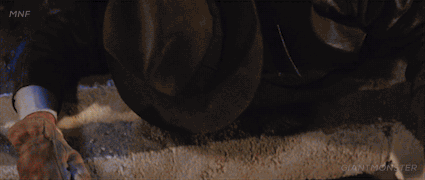
Secrets – Even goody two-shoes Amber from the swim team, with her blonde blonde hair and her good good grades, has a secret. Everybody does, even if it’s not a purposeful, “I have a deep, dark secret,” sort of secret. We have things we don’t tell people, just because they’re embarrassing, or painful, or too deep to get into, or they don’t paint us in a good light. While the secrets themselves tell a lot about a person, so do the reasons a person keeps a secret. Hiding something out of shame suggests a person is prideful, or critical of themselves, or holds themselves to a higher standard than they hold others. Hiding something painful suggests that the person struggles to handle sadness or regret, or that they feel uncomfortable showing raw emotion in front of loved ones. And so on and so forth.
Conflict – Whether internal, interpersonal, legal, moral, societal, or what have you, conflict will limit your character’s actions at every turn. A story is nothing without conflict driving the plot in different directions and causing your character to rethink both their plans and their lifestyle. Without Katniss’s moral conflict over killing other tributes, The Hunger Games would be the story of a girl who entered an arena, killed a lot of people, and lived the rest of her life rich and comfortable. If Luke Skywalker didn’t have interpersonal conflict with Darth Vader, Star Wars would be the war-story of a guy who joined a rebellion and then… yeah.
Health – Physical, mental, and emotional health is a huge limiting factor for characters that often goes untouched, but it’s valuable nonetheless. Not everyone has a clean bill of health and can jump off trains without pulling a muscle, go through a traumatic life experience without any hint of depression or anxiety, or watch a loved one die in gunfire and shove right on without emotional repercussions. Consider creating a character who’s not perfect – who isn’t perfectly in-shape or abled, or neurotypical or stable day-to-day, or completely clean and clear of residual heartache, unhealthy relationships, or bad emotional habits. Don’t define them by these traits, of course – but don’t feel that you can’t write a character with health issues without writing a “sick character.”
So this post got ridiculously long, but I hope it works as a reference for you when creating unique characters. Remember that you don’t need to outline all of this information to create an individual, realistic character. These are just some relevant ideas to get you started! It’s up to you, as the writer, to decide what’s necessary and what’s excessive for your creative process.
Still, I hope a majority of this is helpful to you! If you have any more questions, be sure to send them in and we’ll get back to you :) Good luck!
- Mod Joanna ♥️
If you need advice on general writing or fanfiction, you should maybe ask us!
Hello! How would you write a dialogue in which a character is freaking out about something? I generally have them word vomit but I don't really like that style. If its too much could you show me an example as well?
Hi!
You could definitely word vomit – especially if your character is hysterical – but that’s not the only way to do it by any means. I know a few other ways.
1. Calmly.This is strange, considering your character is freaking out, but the freak-out is internal – they’re shutting themselves off due to shock. In this case, they would be quiet, sane, and even if what they’re saying is illogical, it would probably sound reasonable.
“I was right there when she shot him. He dropped like a sack of flour. I figured he was gone as soon as the bullet hit his chest. So now I’ve decided I’m gonna go after her. Right now. And I’m gonna kill her.”“What? You can’t do that!”“Sure I can. She killed him, so I kill her. It’s called justice.”“But- With just your bare hands?”“The way I feel right now, my bare hands are more than enough.”
Notice how the character who just watched their friend die in front of them isn’t yelling, isn’t stuttering, isn’t getting angry or crying – they’re perfectly calm, almost to the point of complete emotional shutdown.
2. Angrily.Some people get angry when they lose control and freak out – it scares them, and the fear manifests itself as anger. This type particularly happens when they’re upset about something and other characters aren’t taking it seriously or are shrugging off their concerns.
“No! It’s happening tonight! We don’t have time to think, or weigh things, we need to fucking leave! Now!”“We can’t. You know that, and you’d remember that, if you were thinking straight-”“I am thinking straight! It’s you who’s fucked in the head. I don’t give a damn what you think we can and can’t do, we need to clear out of here, right this second.”
As you can see, this character is freaking out – their concerns may or may not have a firm foundation, but obviously they are concerned, and that concern is manifesting itself as fury.
3. By stuttering.For some people, it’s hard to talk when they panic, because their minds race forward ahead of their mouths and they get tongue-tied. I typically see/use this with more anxious characters, or with characters who aren’t typically good at speaking anyways (in other words, who are uncomfortable talking).
There are a couple of different ways to stutter:a. Repeat the beginning of each word.
“I tr-tried to s-save him, but he wuh-wouldn’t l-let me … he knew it was g-going to happen. It’s my f-fault!”
(However, keep in mind that this kind of stuttering is more as if your character is crying and trying to talk through sobs and hiccups. Please use it sparingly – it can get old fast.)
b. Repeat words.
“No. No, I don’t know what’s going on, Ricky. Ricky, why would I have any idea? Don’t fucking look at me like that, Ricky. Don’t look at me like I’m lying.”
c. Insert filler sounds: “ah”, “uh”, “um”, and/or curse words.
“I, uh, I- fuck. I, ummm, I think maybe, ah, maybe we should leave?”
For more on stuttering – it can be hard to peg correctly – check out this post.
I hope this helps! If you need anything else, please feel free to ask. - @authors-haven
How to Write Successful Dialogue
@albino-troll-ninja asked:
Got any feedback/advice/links for someone who wants to make lengthy, relatively action-less dialogues between characters more than just “‘Loren ipsum,’ he said.” “'Ipsum lorem’, she replied.” for forty paragraphs?
No problem! I love dialogue, so I’m happy to be of assistance in this department.
Here are my personal rules of thumb:
1. Allow the dialogue to show the character’s personality.
If you really think about your conversations, it can be telling exactly how much of someone’s personality can shine through when they speak.
Allow your character’s persona, values, and disposition to spill over when they speak, and it will make for a significantly more interesting read for you and your reader.
For example: let’s take a look at a mundane exchange, and see how it can be spruced up by injecting it with a good dose of personality.
Exhibit A)
“How was your day, by the way?” asked Oscar, pouring himself a drink.
“Not too bad,” replied Byron. “Cloudy, but warm. Not too many people.”
“That’s nice.”
Exhibit B)
“How was your day, by the way?” asked Oscar, pouring himself a drink.
“Ugh. Not too bad,” groaned Byron, draping himself on the couch. “Warm, but dreary. Gray clouds as far as the eye could see. Not anyone worth mentioning out this time of year.” A pause. “Well, except me, of course.”
“Hmmph,” said Oscar, glancing over his shoulder. “If it were me, I wouldn’t want it any other way.”
Isn’t that better? Already, the audience will feel as though they’ve gotten to know these characters.
This works for longer dialogue, too: allow the character’s personal beliefs, life philosophy, and generally disposition to dictate how they talk, and your readers will thank you.
Of course, this example is also good for giving the reader a general sense of what the characters’ relationship is like. Which brings me to my next point:
2. Allow the dialogue to show the character’s relationship.
Everyone is a slightly different person depending on who they’re around. Dynamic is an important thing to master, and when you nail it between two characters, sparks can fly.
Work out which character assumes more of the Straight Man role, and which is quicker to go for lowbrow humor. Think of who’s the more analytical of the two and who’s the more impulse driven. Who would be the “bad cop” if the situation called for it.
Then, allow for this to show in your dialogue, and it will immediately become infinitely more entertaining.
Example:
“Alright,” said Fogg, examining the map before him. “Thus far, we’ve worked out how we’re going to get in through the ventilation system, and meet up in the office above the volt. Then, we’re cleared to start drilling.”
Passepartout grinned. “That’s what she said.”
“Oh, for the love of God – REALLY, Jean. Really!? We are PLANNING a goddamn bank robbery!”
Some more questions about dynamic to ask yourself before writing dialogue:
Who is more likely to talk and who is more likely to listen?
Who would talk with their mouth full of food and who would politely wait to swallow?
Is their relationship fraternal/sororal? If so, who would be the “little sibling?”
Is one of them a bit of a mother/father figure to the other?
Who more frequently gets irritated with who?
Who has the more understated sense of humor? Who’s a bit more juvenile?
Who’s better educated? Does it show when they speak?
Who’s a bit more pretentious/full of themselves?
Who interrupts more?
Who swears more?
This can also be a valuable tool to cluing your reader in on who the characters are as people:
3. Think about what this dialogue can tell the reader.
It’s better to fill the reader in more gradually than to waist your valuable first chapter on needless exposition, and dialogue is a great way to do it.
Think about what your characters are saying, and think about ways in which you can “sneak in” details about their past, their families, and where they came from into the discussion.
For example, you could say:
Tuckerfield was a happy-go-lucky Southern guy with domineering parents,
and bore everyone to death.
Or you could have him say:
“Sheesh. All this sneakin’ around in the woods late at night reminds me of being back in Kansas. Good times, man, good times.” There was a pause, before he added, “‘Course, it wasn’t nearly so fun when I came home late for curfew and had to sleep on the front step, but y’know. Life happens.”
Isn’t that much better than the omnipresent monotone?
Dialogue is also a great way to fill in potential plot holes early on, by having your characters talk them out and explain them.
Moreover, dialogue can also be used to foreshadow, offer relevant hints about the climax, or provide information necessary for the resolution.
So use it wisely!
4. Sprinkle in mini-actions throughout.
Even in actionless dialogue, no one actually does nothing. In my case, for example, I stim a lot. I play with my hair. I play with eating utensils. It’s probably very annoying for those around me, but you get the point.
Less fidget-y folks might not do this as much, but they rarely sit totally still during conversations, either. So occasionally add in these mini-actions, and it will make your characters feel a bit less like disembodied voices or floating heads.
For instance:
Jo leaned back in her chair rolling her stiff neck from sitting still for so long. “…So the way I see it,” she continued. “Even if Pheris Beuller’s Day Off didn’t take place in Cameron’s imagination, Pheris was clearly a sociopath whose behavior shouldn’t be glamorized.”
“Ha. As if.” Avery paused to sip her root beer. “Pheris,” she began, raising an index finger. “Was clearly emblematic of counterculturist movements such as the Beat Generation, and his disregard for the capitalistic dogmas imposed upon younger generations is something to be admired.”
“For Christ’s sake, will you two lighten up?” scoffed Leo, counting out bills for the pizza. “We were talking about which movie we wanted to watch tonight. Jesus.”
5. Remember how people actually speak.
In real life conversations, people don’t speak in paragraphs. Alright, some people might, and this can actually be interesting as the personality aspect of a certain type of character.
But generally speaking, people don’t speak in paragraphs, or as though they’re writing thought-out prose or letters.
In real conversations, people stutter. They laugh at their own jokes, repeat words or phrases, and lose their train of thought.
Naturally, you don’t have to illustrate in your writing exactly how chaotic and mundane human speech can be, as writing would be pretty boring in general if it was strictly limited to miming reality. But it’s good to keep in mind that your characters are talking, not writing in purple prose.
Exhibit A:
“When I was a young boy, my mother and I had a most tumultuous relationship,” said Marcus. “She saw me as a hallmark of her past failures, and took every opportunity to remind me as such.”
Exhibit B:
“My mom, when I was kid, we had what you’d call a sort of tumultuous relationship,” said Marcus. “Nothing I ever did was right for her. She, uh – I think she saw me as sort of a hallmark of her past failures. Took every opportunity to remind me of that.”
Which of these is more organic, more easy to visualize, and more telling of character? Unless the point of this dialogue is to illustrate that Marcus is a gentleman crook of some kind with pristine speaking mannerisms, I’m going to say the latter.
Best of luck, I hope this helps, and happy writing! <3

As you all probably know I’m obsessed with Korean skincare, but the focus of kbeauty always seems to be focused on hydration and brightening skin, which is great, but I thought I would make a little list of Korean products that are for acne!
Cosrx Pimple Master Patch: $4.79 for 24 patches. These are great for targeting those large, painful pimples without popping them. Put these on the pimple before bed to dry it out!
Cosrx Centella Blemish Ampule: $21.71. This ampule is great because it’s anti-bacterial and anti-inflammatory to help kill existing bacteria while prevent more from growing, and it is also super soothing and hydrating so it prevents dryness and irritation!
Mizon AHA Peeling Serum: $13.96. This serum will help unclog pores by sloughing off dead skin cells before they can clog you pores! A great chemical exfoliation as opposed to scrubs that can actually cause more acne. Make sure to follow directions and only use 3 to 4 times a week!
Klairs Rich Moist Soothing Mask: $16.88 for 10 sheet masks. These masks are gonna help soothe redness and irritation caused by acne while also hydrating the skin.
Banila Co Clean It Zero Purity: $20.50. This is a great cleanser for sensitive acne prone skin. It’s hypoallergenic and will help get rid of excess oils, which can cause breakouts.
So there you have it! Let me know if you guys want me to do more of these, or if you’ve tried any of the products! Also I know there are a few typos in the picture, sorry!
Some Artist Tips you May or May Not Know
Just from personal experience.
1: Never try to draw on an empty stomach. You’ll make mistakes and be uncomfortable. (But don’t stuff yourself till you’re sick either.)
2: If you have to go to the bathroom, go. A full bladder or otherwise does serious damage to the attention and patience spans. Plus it gives you time to stretch your legs.
3: Before you ink it, leave it alone. Come back later (a few hours, a day?) and check for major anatomy mistakes. Work on something else while you’re waiting.
4: Stay hydrated! The brain and fine motor skills work better when properly circulated.
5: Do not have an excessive amount of sugar before sitting down to work. You’ll get jittery and impatient. Same goes for immense amounts of caffeine.
6: If you’re stuck, take a break to stand and stretch. Walk around the room. But don’t THINK of it as a break. Just take time to really focus on your body. Loosen it up, get a goooood long stretch and some deep breaths. (but don’t pass out!) It’ll jolt the mind awake and let you really relax a moment.
7: Keep. All. Your. Old. Art. I don’t care what it is. Keep it. Date it if it’s in your computer folders. Make a suitcase filled with it. (I personally have ALL my old art in a thick work folder.)
8: Keep your sketchbooks together, used and unused. If there’s a good sale on sketchbooks, get two or three! You won’t regret it later. There’s no such thing as too many. (I currently have about ten spankin’ new sketchbooks and I know I’ll need/use every single one of them.)
9: Date your sketchbooks. Put a start and finish date on them.
10: I’m afraid I don’t practice this one: date your drawings. You’ll be happy about it later. You don’t need to SIGN every drawing, but do date them. At least date pages.
11: ART BLOCK HAPPENS. Art block is pretty much a CONSTANT state of mind for artists. You’re never out of art block totally. But sometimes you get bursts of inspiration that make it feel like you’re out. So instead of feeling like you’re ill if you suddenly have artblock, remind yourself that this happens all the time, and you get out of it eventually, every time. c:>
12: If you’re REALLY stuck on some bad art block, do what I do.
Draw a brain barf. This is where you take a blank sheet of paper, and you just LET your hand be A.D.D. Draw whatever comes to mind, as it comes to mind. in the middle of drawing a hippo in a top hat but you think of a jolly rancher riding a unicycle? Switch immediately.
Let your brain just vomit all over the page. You’ll be surprised what comes up and what art block this can get you out of. It’s gotten me out of it various times.
13: Take advice from more experienced artists. But do NOT take everything as Gospel. Some people are just wrong.
14: HAND SHYNESS/ ART ENVY/ SELF CONSCIOUSNESS/ AND SKILL IMPATIENCE WILL EAT YOU ALIVE like a Titan. Do not let yourself get shy after looking at ‘better art’, do not let yourself think your art is worthless or your skills are worthless, and do not let yourself get frustrated that you cannot be at a higher skill level RIGHT NOW. Your brain will try to do this. All the time. Keep yourself in check. If you keep going at it, and keep working, you will get better. This is why you keep your old art. Look at it to remind you how far you’ve come.
15: Draw what you like. This is so important. (This does not apply for exploitative art. :l That’s just wrong. So long as you’re not targeting someone harmfully, I guess you’re fine.)
But don’t let people’s preferences dictate what you can and can’t draw. Draw whatever the heck you like. Accept that no matter WHAT there will be someone out there that hates it. Always. This is just a fact of life. But don’t let it get you down. I would have stopped being an artist at day one if I had.
16: You never. Stop. Learning. Ever. You will be old and grey and still be learning new things. That’s okay. That’s the nature of art. Even the ‘pros’ don’t know everything.
I hope these help someone out there~







Credits to: @satosan



Books BTS wants us to read
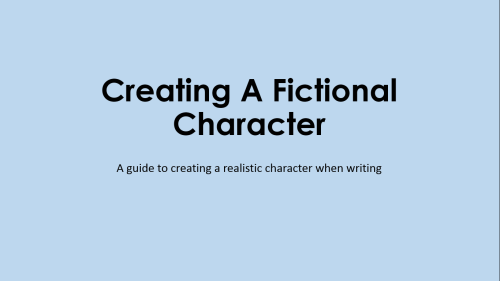

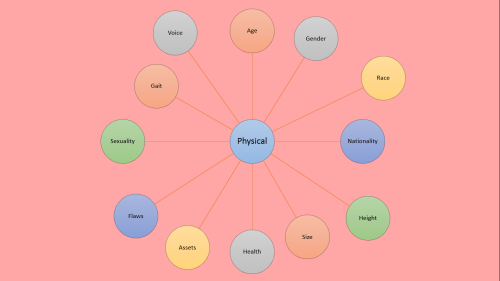

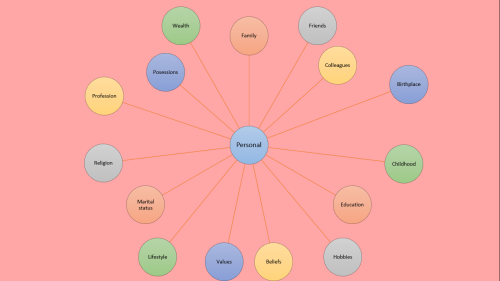
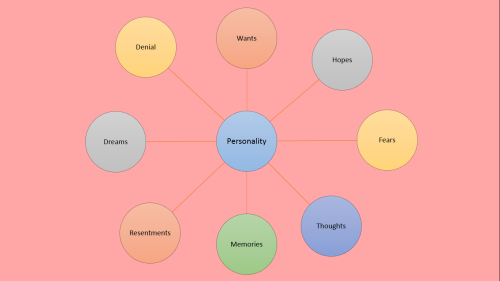
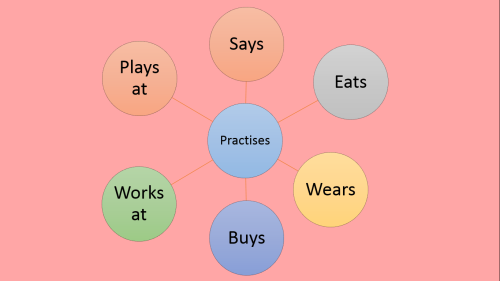
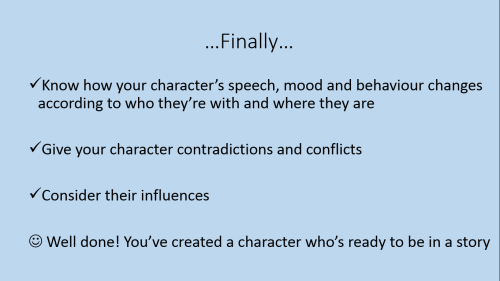
I made a slideshow about how to create a fictional character… I got most of the information from the ‘start writing fiction’ (free) course on the OpenUniversity website and found it incredibly useful so here’s a visual version for you :)
Writing Character Arcs
Post suggested by @amethystvalkyrie.
Let’s get this out straight away: You cannot disregard character arcs. The way you can think of character arcs is that readers usually come for the plot but stay for the character because you can have a kick ass plot but if the characters don’t have depth and don’t grow or change throughout, then the readers can’t connect to the story. Readers need to care about the character to care about what they are going through and the best way to do this is through their arc. Now, though attention to character is always important, certain genres demand more than others just like certain genres demand more plot than others. For example, literary, contemporary YA, and romance put more emphasis of character than more plot-driven genres like thriller, adventure, fantasy and sci fi. In any case, character arc enhances the story but it can be tricky to understand how create this arc and how to use it to better the story, so here are some tips:
Really, think of it as a curve. Okay, so maybe not a nice smooth curve, more like one with a bunch of bumps and squiggles in it. Also, the direction of this curve depends on who you want your character to become. Usually, a protagonist will arc up, starting at point where they have some personal obstacles to overcome, whether this is just a few things or a major attitude adjustment. You can also have characters that arc down and progressively get worse, like a villain or a tragic hero. The point is that as the time goes on, your characters should move on the Y axis (sorry for the math). You can actually plot it out if it helps you understand the rises and falls of your character’s arc.
Find what each character really needs to change. What is holding them back from achieving their goal? Why is it so important that they change? What would happen or who would they be if they don’t change? Alternatively, what can go wrong if they change or change for the worse? Remember that not every character arc is a positive one and sometimes readers need to see the characters fall to understand what is at stake and cheer for them more when they get back up.
Don’t make it sudden or pointless. Like anything else in your story you want to make the character’s advancement (or deterioration) have a cause and effect relationship. Something that happens in the story causes the character to have to change or at least consider how their actions are impacting others and their own life. A drunk who gets into a car accident and nearly kills their kid. A hero whose selfishness nearly causes the destruction of a village. Typically, the biggest shifts happen near the climax where the stakes are highest and the character has to make the biggest decisions.
Don’t make the character passive. Passive characters, in particular passive protagonists are unbearable. These are the ones that have the plot happen to them rather than contributing to the direction and outcome of the events. A character needs to take charge of their own destiny even if it’s a story where destiny is literally coming after them. Like I said before, some genres have more room for this than others. A high-stakes thriller that’s more plot driven has moments where the characters have to struggle to keep up with the events happening to them, but they should still be making the major decisions that ultimately lead to the conclusion. When the characters aren’t being decisive they can’t grow or change and their personal story stays flat and boring.
-
 feverdreamsaredreamt liked this · 4 years ago
feverdreamsaredreamt liked this · 4 years ago -
 13yroldkindawriter liked this · 4 years ago
13yroldkindawriter liked this · 4 years ago -
 bugishere liked this · 4 years ago
bugishere liked this · 4 years ago -
 c0ntr0lledchaos liked this · 4 years ago
c0ntr0lledchaos liked this · 4 years ago -
 silvmakup reblogged this · 4 years ago
silvmakup reblogged this · 4 years ago -
 faryeeta liked this · 4 years ago
faryeeta liked this · 4 years ago -
 androgynouscoffeestrawberry liked this · 4 years ago
androgynouscoffeestrawberry liked this · 4 years ago -
 freddieful liked this · 4 years ago
freddieful liked this · 4 years ago -
 chiefrebelmentality liked this · 4 years ago
chiefrebelmentality liked this · 4 years ago -
 sun-5h1ne reblogged this · 4 years ago
sun-5h1ne reblogged this · 4 years ago -
 sun-5h1ne liked this · 4 years ago
sun-5h1ne liked this · 4 years ago -
 estellence liked this · 4 years ago
estellence liked this · 4 years ago -
 qureshi101 reblogged this · 4 years ago
qureshi101 reblogged this · 4 years ago -
 roserylillies reblogged this · 4 years ago
roserylillies reblogged this · 4 years ago -
 violetride liked this · 4 years ago
violetride liked this · 4 years ago -
 coffebeanz-blog liked this · 4 years ago
coffebeanz-blog liked this · 4 years ago -
 babylonfeeling98 liked this · 5 years ago
babylonfeeling98 liked this · 5 years ago -
 necropasta liked this · 5 years ago
necropasta liked this · 5 years ago -
 unholypudding liked this · 5 years ago
unholypudding liked this · 5 years ago -
 unic0rnns-taking-0verr liked this · 5 years ago
unic0rnns-taking-0verr liked this · 5 years ago -
 lxne20 liked this · 5 years ago
lxne20 liked this · 5 years ago -
 witchvspatriarchy liked this · 5 years ago
witchvspatriarchy liked this · 5 years ago -
 mykyliexoworld liked this · 5 years ago
mykyliexoworld liked this · 5 years ago -
 activecutie liked this · 5 years ago
activecutie liked this · 5 years ago -
 thxrunaways liked this · 5 years ago
thxrunaways liked this · 5 years ago -
 intergalacticunicornqueen liked this · 5 years ago
intergalacticunicornqueen liked this · 5 years ago -
 thatsnotpatrick reblogged this · 5 years ago
thatsnotpatrick reblogged this · 5 years ago -
 adelina27-love liked this · 5 years ago
adelina27-love liked this · 5 years ago -
 crush-royalty liked this · 5 years ago
crush-royalty liked this · 5 years ago -
 studyblrin liked this · 5 years ago
studyblrin liked this · 5 years ago -
 cuntdiary liked this · 5 years ago
cuntdiary liked this · 5 years ago -
 weeabub liked this · 5 years ago
weeabub liked this · 5 years ago -
 racvnteur liked this · 5 years ago
racvnteur liked this · 5 years ago
Right now this is just anything that comes to mind since I'm a complete noob at tumblr. I've been hearing about it for years but I never really felt like I had anything to say. Well all that has changed now and I figured I'd see what all the hype about tumlr is really about. Anyway don't take anything I say too seriously for now...I'll probably change it later when I become more comfortable with this website.
168 posts